As the basis of the marine food chain, phytoplankton are important indicators of change in the oceans. These marine flora also extract carbon dioxide from the atmosphere for use in photosynthesis, and play an important role in global climate. Phytoplankton blooms that occur near the surface are readily visible from space, enabling a global estimation of the presence of chlorophyll and other pigments. There are more than 5,000 different species of phytoplankton however, and it is not always possible to identify the type of phytoplankton present using space-based remote sensing.
Coccolithophores, however, are a group of phytoplankton that are identifiable from space. These microscopic plants armor themselves with external plates of calcium carbonate. The plates, or coccoliths, give the ocean a milky white or turquoise appearance during intense blooms. The long-term flux of coccoliths to the ocean floor is the main process responsible for the formation of chalk and limestone.
This image is a natural-color view of the Celtic Sea and English Channel regions, and was acquired by the Multi-angle Imaging SpectroRadiometer's nadir (vertical-viewing) camera on June 4, 2001 during Terra orbit 7778. It represents an area of 380 kilometers x 445 kilometers, and includes portions of southwestern England and northwestern France. The coccolithophore bloom in the lower left-hand corner usually occurs in the Celtic Sea for several weeks in summer. The coccoliths backscatter light from the water column to create a bright optical effect. Other algal and/or phytoplankton blooms can also be discerned along the coasts near Portsmouth, England and Granville, France.
At full resolution, evidence of human activity is also apparent in this image. White specks associated with ship wakes are present in the open water, and aircraft contrails are visible within the high cirrus clouds over the English Channel.
MISR was built and is managed by NASA's Jet Propulsion Laboratory, Pasadena, CA, for NASA's Office of Earth Science, Washington, DC. The Terra satellite is managed by NASA's Goddard Space Flight Center, Greenbelt, MD. JPL is a division of the California Institute of Technology.

 Planetary Data System
Planetary Data System












